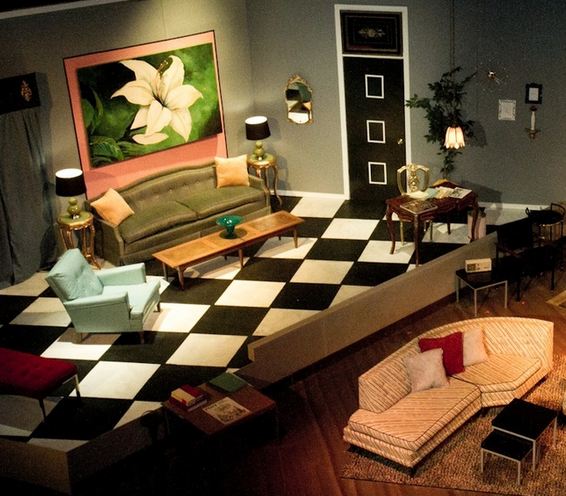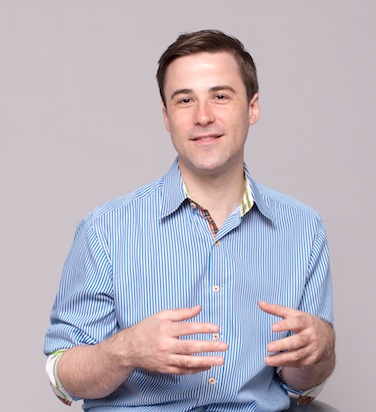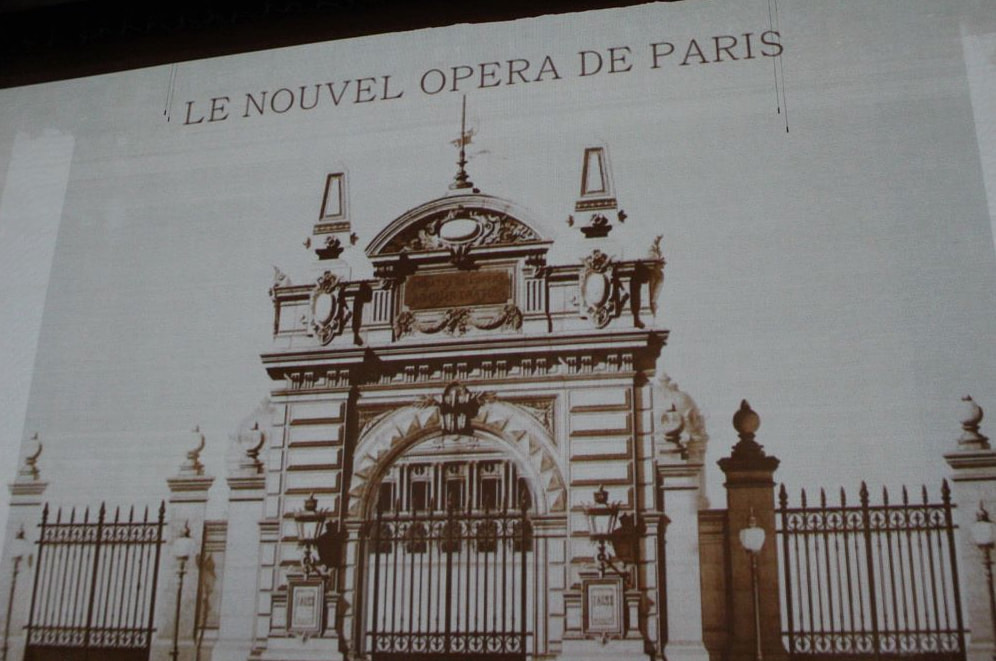|
The other week I meet a legendary designer, a designer I've always wanted to meet. Carleton Varney, one of America's best-known interior designers is president of Dorthy Draper & Company , the oldest established interior design firm in the United States. He is associated with the restoration of countless hotels and resorts all over the world. The author of over 34 books on design and decorating, he continues the tradition of Dorthy Draper by being associated with the use of bold and vibrant colors. I had the chance to show him pictures of a set design I based off of a hotel Dorthy Draper designed, Pillow Talk (the play version of the Doris Day and Rock Hudson movie). To my surprise he loved the design and said I captured the look very well and he gave me his blessings. I was over the moon! Carleton Varney and Joseph Cummings The left is my design for Pillow Talk and to the right is the Dorthy Draper design. You can see the influence, bold colors and fabrics with vintage furniture. This was a special day for me! Thank you Mr. Varney for being gracious and kind!
0 Comments
One of my favorite designer's is being interviewed on her design process and her work. Read the article below and take a look at the behind the scenes work of an amazing set designer. An Interview with Anna LouizosWritten by Victoria Myers Photography by Jessica Nash September 27th, 2016 The shelves of set designer Anna Louizos’ office are lined with shadow boxes that feature scenes from the various shows that she’s designed. They’re part of her effort to re-purpose set models, but they also offer a glimpse into the magical and hermetic worlds of her designs. Her body of work, ranging from big Broadway musicals to intimate plays, is also represented on the posters that line her studio wall and the set models with their moving parts. Anna has been Tony-nominated for her work on The Mystery of Edwin Drood, High Fidelity, and In the Heights. She’s also designed the sets for Curtains, Speech and Debate, Rodgers and Hammerstein’s Cinderella, and School of Rock, just to name a few. Most recently, she designed the sets for the Roundabout Theatre Company’s production of Holiday Inn, which takes audiences from the Connecticut countryside to the back lots of Hollywood. Anna is one of very few female set designers to have worked on Broadway, and we talked with her about her design process, her dream to start a theatre museum, the challenges female designers face, and much more.
When you get a show like Holiday Inn, how does your design process work? You read the script, and then what do you do from there? The first thing I notice with a play like Holiday Inn is it reads like a movie. It’s based on a movie so it does read like a movie. I find that a lot of scripts lately, especially musicals, tend to be written with a kind of flow that reminds me of film, it’s where things just go from one scene to the next without any real thought about how you get from one place to the other. Holiday Inn, I’ve been familiar with that movie since I was a kid. I used to watch it on TV. I have a great affection for it and I love the fact that it’s set in the 1940s. Clearly, that’s an important way to convey the style of the piece. I start by pulling research, looking for stylistic visual material—magazines from the 1940s, home decorating magazines of the 40s. I have these Great American Home magazines that show advertisements from that period of time and the interior design look of homes. I pull anything that relates to each of the scenes, first of all, just for inspiration, and then I put together a book of visual material and meet with the director [Gordon Greenberg], and Gordon and I just start talking about how we think various things look. That’s the one component, the style of the piece, but then the other component is the nuts and bolts, and that’s really my job: to figure out how to get from a nightclub to a country lane, to the outside of the house, to the inside of the house, back to a nightclub, and it all has to happen in a very seamless way. I might start by making little thumbnail sketches of what I think the stage picture could look like and try to free my mind and not get too bogged down in how it happens, but mostly just think, “What do I want the pictures to look like?” Sometimes when I start that process, I start to notice where there might be something in common between [set pieces] that might allow me to, for example, form tracking portals or certain pieces that can shift on stage and off to create a larger opening or smaller opening. It’s a very complicated way to figure it out, but I think it’s like creating a jigsaw puzzle without knowing what the picture is. You need to make the puzzle pieces fit and eventually you have to figure out what the pictures look like. It’s a long, drawn out process, trial and error, flushing things out in model form, doing little rough model versions of things. It’s also very important to know the size and the limitations of the space. The first thing we do is we build a model box of the theatre so we know exactly what our limitations are. Right, there’s only so much wing space. [For example] We have to go from the inn’s living room to the inn’s performance space, and given the limitations of the theatre we only have so much depth, so we can’t go deeper into the inn, we just have to peel away what’s there so that we can create an open stage space. We wanted a nice staircase to suggest that there’s an upstairs. The staircase we have doesn’t fit off stage. The whole thing has to telescope so that it can get off stage. In the script it talks about how the house falls apart when he [Jim, the main character] closes the door and, all of a sudden, all these things happen. We had to figure out what sequence of events would happen that would indicate that the house is falling apart. The staircase had to be rigged specially so that the wood posts and the railing could collapse, and the curtain had to be rigged so that it could drop, and the picture has to go cockeyed. All these things have to be part of how the whole thing gets built. It just seems very complicated. |
My blog is all about the design process, set design,designers I love and architecture. Take a look behind the curtain!
Recommended
|
Photos from gnalnad, See-ming Lee 李思明 SML, lmnop88a, i eated a cookie, Hythe Eye, ReneS, quinn.anya, FranUlloa, neotint, cleverclevergirl, Cali4beach, louis.foecy, Ack Ook, Kiwithing, Becaroona, faceleg, Vix_B, flik, Dave_B_, ed 37 ~~, osseous, Meredith Bell, Bob B. Brown, Satyricon86, Dr Momentum, oskay, David Guidi, Garrette, Auslandsoesterreicherflickraccountinhaber, gui.tavares, cloverhunter (ex crystalbat), visualpanic, OliBac, Courtney Dirks, Ack Ook, mccun934, betsyweber, padsbrother, NwongPR, lissalou66, shawncampbell, rafeejewell, L. Marie, f_shields, flickrsven, LuaCheia72, Steve Nagata, Hannes R, melloveschallah, sharonmleon, Dylan Parker, Canned Muffins, Loren Javier, Will Scullin, stevegarfield, melloveschallah, jnewland, BenjaminThompson, anna.j., romana klee, Svadilfari, Steve Snodgrass, J Wynia, dustin.askins, gordasm, dalbera, ellenm1, Brent Schmidt, quinn.anya, erin MC hammer, _rockinfree, mrbill, ZeHawk, LostinTexas, Napalm filled tires, awyu322, Horia Varlan, Obliot, Robert S. Donovan, nimishgogri, jczart, flattop341, x-ray delta one, M$$MO, Darwin Bell, tornatore, dherrera_96, Navin75, Doctor Hyde, joelogon, Brent Schmidt, BWChicago, Loren Javier, Draco2008, Wallula Junction, piermario, Traveling Fools of America, tiny pig, Luiz Fernando / Sonia Maria, Nadia Szopinska, various brennemans, vancouverfilmschool, gliuoo, David Reber's Hammer Photography, Xtremo, Gnilenkov Aleksey, striatic, {Guerrilla Futures | Jason Tester}, matsuyuki, Martin Labelle, Elin B, Loren Javier, Kjunstorm, swanksalot, B Rosen, REVIVALthedigest, Steve Nagata, ThrasherDave, Kirsten Hartsoch, Mataparda, Brett Jordan, bluesmoon, Milosz1, jeffkarpala, tibbygirl, healthserviceglasses








